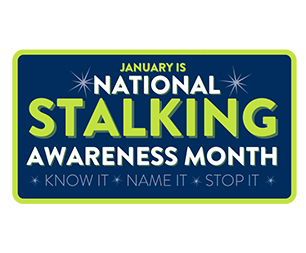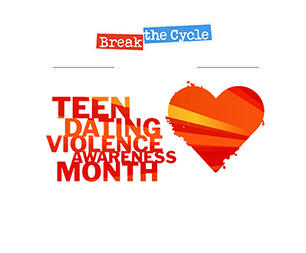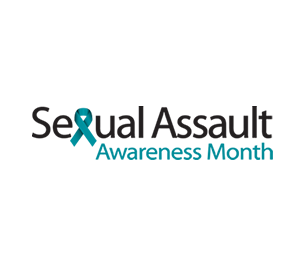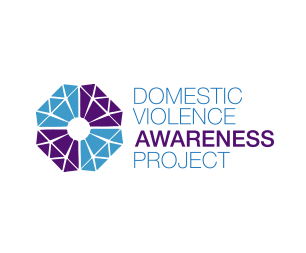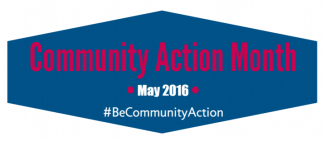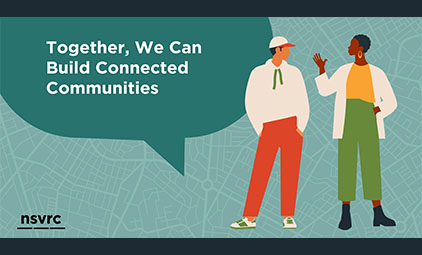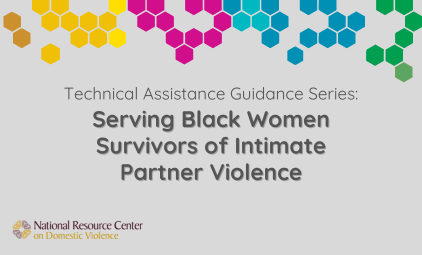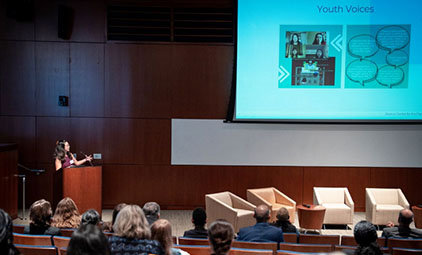by Patty Branco for the National Resource Center on Domestic Violence
This May, let’s bring our attention to the importance of building and sustaining partnerships between domestic violence programs and anti-poverty organizations, as we celebrate and promote National Community Action Month. This observance was created by the Community Action Partnership (CAP) to reinforce the critical role of Community Action Agencies (CAAs) in helping low-income families achieve economic stability. Throughout the month of May, CAP directs its communication efforts into recognizing and celebrating the work that CAAs are doing around the country.
Why This Is So Important
“We have always argued that to end the conditions that breed violence and trap women in abuse, we have to end economic and racial inequality. Women can’t escape from abuse when they have nowhere to go, no help to get there, and no money. By ourselves, domestic violence programs will never solve these economic, housing, and health problems. They require solutions and coalitions far bigger than those we have yet designed.” – Susan Schechter
Domestic violence advocates know all too well that poverty (or the threat of) creates significant barriers to survivors’ safety. Individuals across all socio-economic classes experience domestic violence. Poverty does not cause domestic violence but it often exacerbates the severity and frequency of abuse. On the other hand, domestic violence may cause economic problems for victims and entrap them in poverty and an abusive relationship (Renzetti, 2009). Advocates also know (or ought to know) that no one social justice movement or service system can work effectively in isolation. People faced by complex issues like domestic violence often utilize multiple services and systems in order to meet their various needs, which may include finding affordable childcare, safe housing, jobs and job training, and quality health care services. Anti-poverty organizations such as community action agencies can play a key role in helping survivors access critical programs and resources that may fall outside the scope of the traditional services offered by domestic violence organizations.
Established under the Economic Opportunity Act of 1964 to fight America’s War on Poverty, CAAs are nonprofit private and public organizations with the mission of “help[ing] people to help themselves in achieving self-sufficiency” (Community Action Partnership). Across every U.S. state, as well as Puerto Rico and the Trust Territories, more than 1,000 CAAs (National Community Action Foundation) help low-income people and families by offering an array of services and opportunities, including financial education, job training, affordable housing, natural disaster relief and recovery, health care, energy assistance, community and economic development, Head Start programs, Individual Development Accounts, and more. In some communities, the CAA also offers specialized services to women, men and children experiencing domestic violence, including 24-hour crisis hotline, safety planning and emergency shelter.
How You Can Be Involved
By collaborating with CAAs, domestic violence organizations can support the vital work these agencies are already doing for abuse survivors and/or help them establish helpful services, if these are not yet in place (and vice-versa). Such collaborations will require shared resources and a collective understanding around common values, goals and vision, including concerted efforts around cross-training and fostering “buy-in” for key stakeholders. While this post does not explore the fuller process of building and sustaining collaborations between anti-poverty and anti-violence organizations, it highlights several ways in which domestic violence programs can support and promote National Community Action Month in May, laying the foundation for further collaborative work throughout the year.
Training staff on economic advocacy and justice. This month presents a timely opportunity for domestic violence programs to build the capacity of advocates to provide economic advocacy and collaborate successfully with new partners such as anti-poverty agencies. Through its Building Comprehensive Solutions to Domestic Violence (BCSDV) initiative, the National Resource Center on Domestic Violence offers curricula and various policy and practice papers providing anti-violence organizations with guidance for integrating economic advocacy into their core work with survivors. The Economic Justice Project of the National Network to End Domestic Violence offers training tools to strengthen advocates’ financial capabilities to better assist survivors “move from short-term safety to long-term security, and to an economically sustainable independent life.” A wealth of resources is also available on VAWnet on topics such as building credit and assets, tax credits, employment, housing and more.
Downloading and sharing the Toolkit. The Community Action Month Toolkit offers creative ideas and fun activities for every day of the month, as well as news release and proclamation templates and sample Tweets and Facebook posts. Downloading and sharing the toolkit is an easy and tangible way for domestic violence advocates to get involved in National Community Action Month.
Connecting on social media. As a starting point, domestic violence programs can connect with the Community Action Partnership and their local CAA on social media. Anti-violence advocates can use Twitter, Facebook, Instagram and Pinterest not only to share the Community Action Month Toolkit and shine the spotlight on the work of their CAAs, but also to highlight their own outcome data and success stories of helping abuse survivors access economic resources and achieve long-term financial stability. (Be sure to follow @CAPartnership and use the hashtag #BeCommunityAction in your social media communications!)
Supporting CAAs’ local events. Throughout the month of May, CAAs host awards events to honor customers, volunteers and staff. Elected officials may be present at these events to issue formal proclamations recognizing the important work being done by CAAs in the community. In addition, state and regional associations may host conferences to network and provide training on poverty related issues. Domestic violence advocates can help make their local community action agency’s event a success by attending the event, co-sponsoring and/or hosting it. Given the various constituencies at attendance (funders, elected officials, local businesses, non-profit organizations, the general public), it is a great idea for domestic violence advocates to have resource tables set up at CAAs’ events to share general information about domestic violence and highlight the life-saving services provided by their program. (Find your local CAA.)
Celebrating staff and volunteers. During National Community Action Month, CAAs are encouraged to celebrate staff and volunteer excellence with awards ceremonies at the local level. Similarly, domestic violence programs can take this opportunity to organize an annual awards celebration to honor advocates who have done outstanding economic advocacy work with survivors and/or championed successful collaborations with anti-poverty agencies. During this month, local programs can also identify successful stories and potential nominees (both program participants and volunteers) for the Community Action Partnership’s Sargent Shriver Achievement and Jayne Thomas Grassroots Volunteer Recognition Awards.
Educating the community. CAAs use National Community Action Month to shed light on poverty-related problems. “As Community Action Agencies are showcasing their programs, they are also giving local residents – many who are unaware of the poverty in their communities – a first-hand look at the struggles low-income families face and how Community Action programs help these families achieve financial security” (Community Action Partnership). This month can also be a timely opportunity for domestic violence advocates to call attention (via social media, publications and community presentations) to the economic needs of abuse survivors and to educate the community about the relationship between domestic violence and poverty and how “each make the other problem more difficult to escape” (Schechter, 1999). More importantly, National Community Action Month provides a forum for anti-violence and anti-poverty organizations to “show and tell” how they are working together in their communities to help survivors be safer from physical harm, while also meeting their basic human needs and achieving long-term financial security.
Happy National Community Action Month, and let’s be reminded that the strength of the anti-violence movement relies on its commitment to address multiple forms of oppression and build collaborative relationships with allied social justice movements! As we do so, here are some important considerations, adapted from Susan Schechter’s work, to guide us through the process:
- Survivors need (and therefore we need) caring people in many places;
- There are many more survivors than we will ever see in domestic violence organizations;
- We want a world in which, wherever a survivor goes, someone is prepared to help;
- We want a world in which people’s basic human needs are met, and, as a result, they can live decently; and
- We want everyone to care about ending violence.
How is your program collaborating with anti-poverty agencies in your community? Please share examples and lessons learned!










